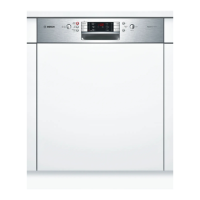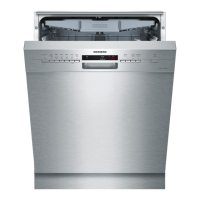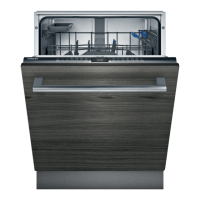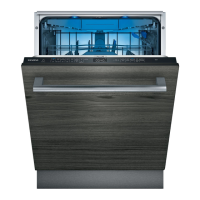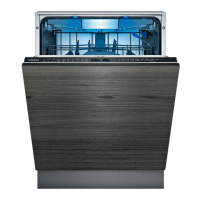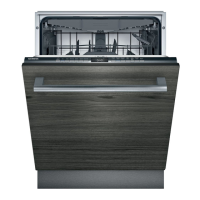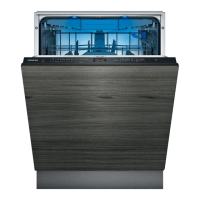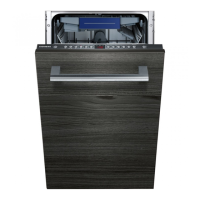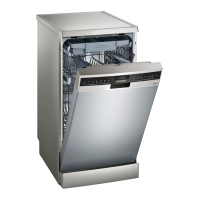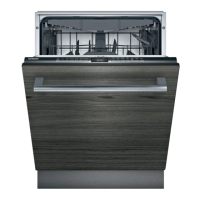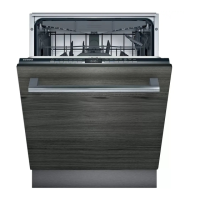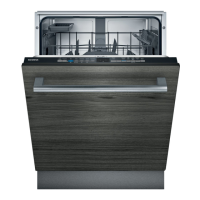Why can't I close the door of my Siemens ?
- CcolonbrittanySep 10, 2025
If you cannot close the door of your Siemens dishwasher, the door lock may be activated. Try closing the door with greater force to reset it.
Why can't I close the door of my Siemens ?
If you cannot close the door of your Siemens dishwasher, the door lock may be activated. Try closing the door with greater force to reset it.
Why are my utensils not drying in Siemens Dishwasher?
If utensils are not drying in your Siemens dishwasher, it could be because the appliance door was opened too early, a program without drying was selected, or too little rinse aid was used. Make sure to let the cycle complete, select a program with drying, and use enough rinse aid.
Why can't I change a setting or start a program on my Siemens ?
If you can't change a setting or a program starts unexpectedly on your Siemens dishwasher, you may have pressed the wrong program button or not waited until the previous program ended. Terminate the program and start again, or wait until the program is completed.
What to do if 'Check water supply' display lights up on Siemens Dishwasher?
If the “Check water supply” display lights up on your Siemens dishwasher, it could be due to several reasons: the tap might be turned off, the water supply could be interrupted, the supply hose might be kinked, or the filter in the water supply could be blocked. Check these potential issues to resolve the problem.
Why is water left in my Siemens Dishwasher after the cycle?
If water remains in your Siemens dishwasher after the program finishes, it could be due to a blocked or kinked waste water hose, a blocked waste water pump (or the cover not locked), blocked filters, or the program hasn't fully ended. Wait for the digital display to show ‹:‹‹ or use the “Reset” function.
Why is there food residue on utensils in my Siemens ?
If you find food residue on utensils after a wash cycle in your Siemens dishwasher, several factors could be responsible: utensils may be too close together or the basket is overfilled, there may be too little detergent, the rinse program might be too weak, spray arm rotation could be obstructed, spray arm nozzles or filters might be blocked or incorrectly inserted, the waste water pump could be blocked, or the top basket isn't set to the same height on both sides. Check these potential causes.
Why is tea or lipstick residue not completely removed in my Siemens ?
If tea or lipstick residue isn't fully removed by your Siemens dishwasher, the detergent may have an inadequate bleaching effect, the rinsing temperature may be too low, or you may be using too little or an unsuitable detergent. Consider using a detergent with better bleaching capabilities, ensuring a higher rinsing temperature, and using an adequate amount of suitable detergent.
Why are my glasses dull and discolored after using the Siemens ?
Dull, discolored glasses with a film that can't be washed off after using your Siemens dishwasher may be due to unsuitable detergent or the glasses not being dishwasher-proof. Ensure you use appropriate detergent and dishwasher-safe glasses.
Why is my Siemens Dishwasher door difficult to open?
If the door of your Siemens dishwasher is difficult to open, the child-proof lock may be activated. Refer to the instructions at the back in the envelope for deactivation.
Why is my Siemens Dishwasher producing unusual foam?
Unusual foam in your Siemens dishwasher suggests that handwash liquid is present in the rinse aid dispenser. Remove the handwash liquid from the rinse aid dispenser.
Guidelines for checking packaging, disposing of materials, and correctly installing the dishwasher.
Important warnings regarding appliance installation, potential injury risks, and safety precautions.
Instructions for safe daily operation and precautions when children are present.
Guidance on addressing faults, safety during repairs, and proper disposal of old appliances.
Overview of the control panel, its buttons, and the interior layout of baskets and components.
Explanation of how to use the display and buttons to select programmes and options.
Steps for selecting the initial language and gathering necessary operating materials like salt and rinse aid.
Procedure to follow if the wrong language is selected during initial setup.
Step-by-step instructions for filling the salt dispenser, including important notes and warnings.
Information on why soft water is important and how tap water hardness affects dishwasher performance.
Detailed steps to manually set the water softening system based on tap water hardness levels.
Explanation of how rinse aid ensures sparkling glasses and stain-free utensils.
Instructions for filling the rinse aid dispenser, with tips for easy access and avoiding spillage.
List of materials and items that should not be cleaned in the dishwasher to prevent damage.
Advice on choosing dishwasher-safe items and selecting appropriate programmes to avoid damage.
Principles for arranging dishes, cutlery, and cookware for optimal cleaning and preventing damage.
Advice on loading cups, glasses, pots, pans, and cutlery, including using folding spikes.
Instructions for using spray heads, knife racks, and shelves for specific items like baking sheets and tall glasses.
Methods for adjusting the height of the top basket to accommodate larger utensils in either basket.
Steps to adjust the top basket using upper and lower roller pairs for height variation.
Method for adjusting the top basket height using side levers (Rackmatic system) for optimal loading.
Overview of different dishwasher detergent types and their properties, including phosphates and chlorine content.
Important notes and cautions regarding the use of combined cleaning products like all-in-one tablets.
Description of the graduated detergent dispenser and its markings for accurate dosage.
Step-by-step instructions for adding detergent to the dispenser, including tips for different door positions.
Instructions on how to properly open and close the dishwasher door, ensuring it latches securely.
Information on how the detergent dispenser cover behaves during the wash cycle.
Steps to turn on the dishwasher using the main switch and ensure necessary refills are done.
How to navigate the main menu to select from the available wash programmes using the buttons.
Explanation of how automatic programmes adjust to load and soiling for optimal efficiency.
A guide to selecting the appropriate wash programme based on utensil type, food remains, and soiling level.
Explanation of the typical stages of a wash programme, including cleaning and drying phases.
Information on programme data, timer, drying, buzzer volume, and rinse aid dosage settings.
How to adjust water hardness settings and other programme-specific options for optimal performance.
How to change the language displayed on the appliance, with a list of available languages.
List of standard programmes that can be selected in addition to automatic programmes.
A table detailing standard programmes based on utensil type and food remains.
Steps for starting a selected wash programme, including door closing and time displays.
How to pause a running programme, with warnings about not using the terminate button.
Procedures for terminating a programme prematurely and understanding end-of-programme notifications.
Steps to safely turn off the dishwasher after the programme has ended and unplug it.
Instructions for cleaning the appliance interior, door seal, and checking salt/rinse aid indicators.
Detailed guide on how to remove, clean, and reassemble the filter system to prevent pump blockages.
Instructions for inspecting, cleaning, and refitting the upper and lower spray arms to ensure proper function.
Steps to resolve pump blockages caused by food debris, involving filter removal and cover inspection.
Troubleshooting appliance startup problems, language settings, and water supply issues.
Solutions for issues like unusual foam, program stops, knocking sounds, and water remaining after cycles.
Addressing common problems with dishes, cutlery, and glasses, including soiling, discolouration, and drying.
Critical safety warnings regarding appliance repairs and handling faults.
Information on contacting customer service, appliance disposal, and comparison test details.
Notes on installation requirements, securing the appliance, and the recommended installation sequence.
Instructions for waste water connection and initial delivery checks.
Requirements for fresh water supply and electrical connection, including pressure, flow, and safety.
Procedures for safely disconnecting, transporting, and protecting the appliance from freezing temperatures.
Details the conditions under which the Aqua-Stop warranty is valid, including correct installation and coverage.
Information on the extent of liability for water damage caused by Aqua-Stop malfunction and warranty duration.
Guidelines for checking packaging, disposing of materials, and correctly installing the dishwasher.
Important warnings regarding appliance installation, potential injury risks, and safety precautions.
Instructions for safe daily operation and precautions when children are present.
Guidance on addressing faults, safety during repairs, and proper disposal of old appliances.
Overview of the control panel, its buttons, and the interior layout of baskets and components.
Explanation of how to use the display and buttons to select programmes and options.
Steps for selecting the initial language and gathering necessary operating materials like salt and rinse aid.
Procedure to follow if the wrong language is selected during initial setup.
Step-by-step instructions for filling the salt dispenser, including important notes and warnings.
Information on why soft water is important and how tap water hardness affects dishwasher performance.
Detailed steps to manually set the water softening system based on tap water hardness levels.
Explanation of how rinse aid ensures sparkling glasses and stain-free utensils.
Instructions for filling the rinse aid dispenser, with tips for easy access and avoiding spillage.
List of materials and items that should not be cleaned in the dishwasher to prevent damage.
Advice on choosing dishwasher-safe items and selecting appropriate programmes to avoid damage.
Principles for arranging dishes, cutlery, and cookware for optimal cleaning and preventing damage.
Advice on loading cups, glasses, pots, pans, and cutlery, including using folding spikes.
Instructions for using spray heads, knife racks, and shelves for specific items like baking sheets and tall glasses.
Methods for adjusting the height of the top basket to accommodate larger utensils in either basket.
Steps to adjust the top basket using upper and lower roller pairs for height variation.
Method for adjusting the top basket height using side levers (Rackmatic system) for optimal loading.
Overview of different dishwasher detergent types and their properties, including phosphates and chlorine content.
Important notes and cautions regarding the use of combined cleaning products like all-in-one tablets.
Description of the graduated detergent dispenser and its markings for accurate dosage.
Step-by-step instructions for adding detergent to the dispenser, including tips for different door positions.
Instructions on how to properly open and close the dishwasher door, ensuring it latches securely.
Information on how the detergent dispenser cover behaves during the wash cycle.
Steps to turn on the dishwasher using the main switch and ensure necessary refills are done.
How to navigate the main menu to select from the available wash programmes using the buttons.
Explanation of how automatic programmes adjust to load and soiling for optimal efficiency.
A guide to selecting the appropriate wash programme based on utensil type, food remains, and soiling level.
Explanation of the typical stages of a wash programme, including cleaning and drying phases.
Information on programme data, timer, drying, buzzer volume, and rinse aid dosage settings.
How to adjust water hardness settings and other programme-specific options for optimal performance.
How to change the language displayed on the appliance, with a list of available languages.
List of standard programmes that can be selected in addition to automatic programmes.
A table detailing standard programmes based on utensil type and food remains.
Steps for starting a selected wash programme, including door closing and time displays.
How to pause a running programme, with warnings about not using the terminate button.
Procedures for terminating a programme prematurely and understanding end-of-programme notifications.
Steps to safely turn off the dishwasher after the programme has ended and unplug it.
Instructions for cleaning the appliance interior, door seal, and checking salt/rinse aid indicators.
Detailed guide on how to remove, clean, and reassemble the filter system to prevent pump blockages.
Instructions for inspecting, cleaning, and refitting the upper and lower spray arms to ensure proper function.
Steps to resolve pump blockages caused by food debris, involving filter removal and cover inspection.
Troubleshooting appliance startup problems, language settings, and water supply issues.
Solutions for issues like unusual foam, program stops, knocking sounds, and water remaining after cycles.
Addressing common problems with dishes, cutlery, and glasses, including soiling, discolouration, and drying.
Critical safety warnings regarding appliance repairs and handling faults.
Information on contacting customer service, appliance disposal, and comparison test details.
Notes on installation requirements, securing the appliance, and the recommended installation sequence.
Instructions for waste water connection and initial delivery checks.
Requirements for fresh water supply and electrical connection, including pressure, flow, and safety.
Procedures for safely disconnecting, transporting, and protecting the appliance from freezing temperatures.
Details the conditions under which the Aqua-Stop warranty is valid, including correct installation and coverage.
Information on the extent of liability for water damage caused by Aqua-Stop malfunction and warranty duration.
| Brand | Siemens |
|---|---|
| Model | Dishwasher |
| Category | Dishwasher |
| Language | English |
